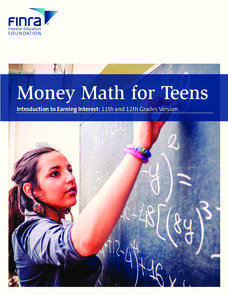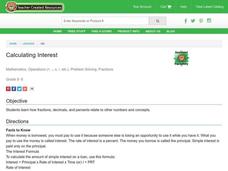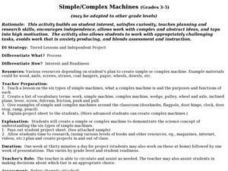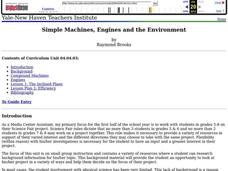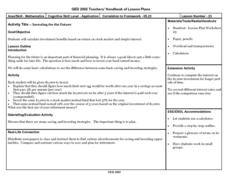Council for Economic Education
Calculating Simple Interest
How much is owed? A calculated resource introduces the simple interest formula with a video that describes how to use it. Classmates then show what they know by answering questions within a simple interest worksheet.
EngageNY
Simple Interest
An interesting lesson helps young financial wizards determine the amount of money earned via interest. The resource introduces the concept of simple interest to show how money can grow. Pupils use their knowledge of percents to solve...
West Contra Costa Unified School District
Interest and the Number e
Mary, Mary, quite continuously, how does your money grow? Uses examples to examine the difference between simple interest and compound interest, and to take a look at different rates of compounding. Learners explore what would...
EngageNY
Why Do Banks Pay YOU to Provide Their Services?
How does a bank make money? That is the question at the based of a lesson that explores the methods banks use to calculate interest. Groups compare the linear simple interest pattern with the exponential compound interest pattern.
Curated OER
Simple Interest
Eighth graders practice finding simple interest and apply their findings to real-world situations. They work with percents in the form of commission and sales taxes. After completing an assignment during independent practice, they are...
SaveandInvest.org
Introduction to Earning Interest: Middle School
Does your bank pay you for allowing them to hold your money? Class members research three different ways they can earn money using money already in the bank. Topics include certificates of deposit, statement savings accounts, and...
Curated OER
M & M Interesting
Students compute and collect interest payments in the form of M&M candies. In this mathematics instructional activity, students work in small groups to compute either simple or compound interest. They compare the growth of their...
SaveandInvest.org
Introduction to Earning Interest: Grades 9-10
Does your bank pay you for allowing them to hold your money? The instructional activity covers three different ways your money can make money. Topics include certificates of deposit, statement savings accounts, and money market accounts.
SaveandInvest.org
Introduction to Earning Interest: Grades 11-12
Does your bank pay you for allowing them to hold your money? Class members investigate three different ways money can make more money. Topics include certificates of deposit, statement savings accounts, and money market accounts....
Curated OER
M&M Interesting
Students examine the concepts of trade-offs and opportunity cost to decide between savings accounts with simple interest and those with compound interest. They calculate interest earned on account balances while working in groups and...
Curated OER
Investment Problems
In this investment problem worksheet, pupils read story problems and use the interest formula to determine the total amount invested, or rate of return. This one-page worksheet contains six problems, with answers.
Curated OER
Interesting Interest Rates
Your young bankers compare earning interest accumulated yearly and monthly to decide which method most increases their balance. Using an exponential function to model the bank balance affords the learners more practice connecting...
Curated OER
Simple Machines
Learners examine six simple machines and investigate who Rube Goldberg is. They explore various websites, write an article, write ten interesting facts about Rube Goldberg, and design and construct a simple machine.
Curated OER
The Business of Interest
Students explore the concept of simple and compound interest. In this interest lesson, students discuss how interest works on a loan. Students calculate simple and compound interest on loans of fictitious characters from a video.
Curated OER
Introduction to Earning Interest: What are APR and APY?
Students explore saving and investing money. In this middle school personal finance lesson, students define and use investment vocabulary, explore compound interest and its effect of savings, and compute simple and compound...
Curated OER
Compound Interest
Students solve compound interest problems. For this solving compound interest problems lesson, students use TVM Solver on the Ti-83 Plus. Students find the future value of a principal amount at a given interest rate compounded a certain...
Teach Engineering
The Advantage of Machines
Show your students how to make their work easier. The first lesson plan in a series of 10 introduces the class to work and the way simple machines can be make work easier. The simple machines scholars can find in everyday items are...
Curated OER
Compound Interest
In this consumer math worksheet, students read an example of how to use the interest formula to compute interest that is compounded daily over six years. They complete a chart where they compute the interest earned over 10 years when the...
Curated OER
Calculating Interest
Students explore the concept that when money is borrowed, people pay to use it because someone else is losing an opportunity to use it while they have it. What you pay to use the money is called interest. The rate of interest is a...
Curated OER
Data Analysis: Investing is an "Interesting" Experience
Students compute interest earned. In this data analysis activity, students examine investments and interest rates. They compute the total interest earned and find the simple interest.
Curated OER
Simple/Complex Machines
Students make a simple machine. In this physics instructional activity, students learn about six types of simple machines and the purpose of each and brainstorm examples of simple and complex machines in the classroom. Students...
Curated OER
Simple Machines, Engines and the Environment
Fourth graders calculate the mechanical advantage of an inclined plane. In this physics lesson, 4th graders identify the different types of simple machines and their uses. They give examples of compound machines.
Curated OER
Investing for the Future
Twelfth graders perform basic calculations for saving and investment strategies. they simulate the investment of $1,000 in the stock market and savings account. they determine which pays the greater dividend.
Curated OER
Health Career Planner - Interest Inventory
Career exploration can begin with something as simple as a personal interest inventory. Learners complete a list of personal interests, determine their personality type, and then discuss how suited they'd be to a health care career.
Other popular searches
- Simple Interest Formula
- Simple Interest Rates
- Calculating Simple Interest
- Simple Interest and Math
- Worksheet on Simple Interest
- Simple Interest Earned
- Computing Simple Interest
- Simple Interest Worksheet
- Simple Interest Loans
- Simple Interest Activities
- Money Simple Interest
- Simple Interest Calculation








